Gigabyte GA-X99-UD4 User Manual

GA-X99-UD4
User's Manual
Rev. 1002
12ME-X99UD4-1002R
For more product details, please visit GIGABYTE's website.
To reduce the impacts on global warming, the packaging materials of this product are recyclable and reusable. GIGABYTE works with you to protect the environment.
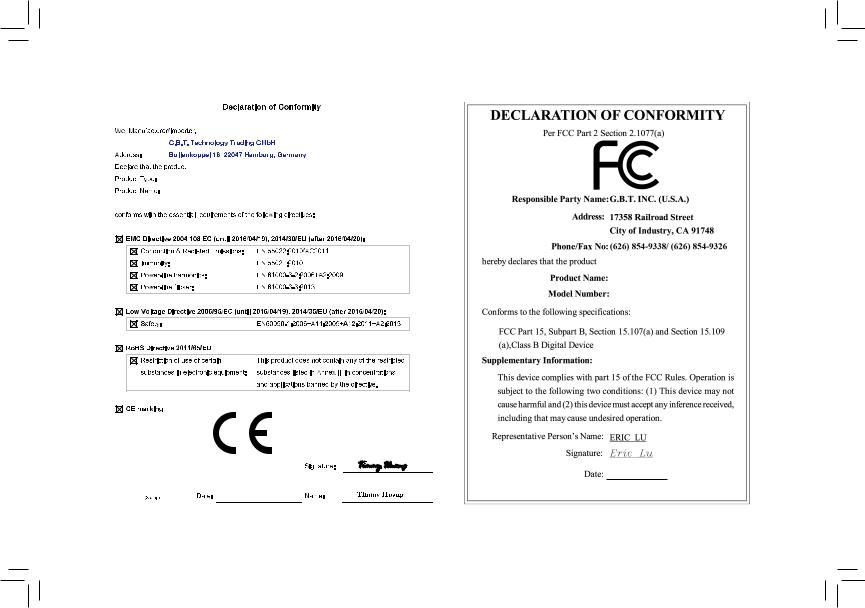
Motherboard
GA-X99-UD4
Aug. 15, 2014
Motherboard
GA-X99-UD4
Aug. 15, 2014
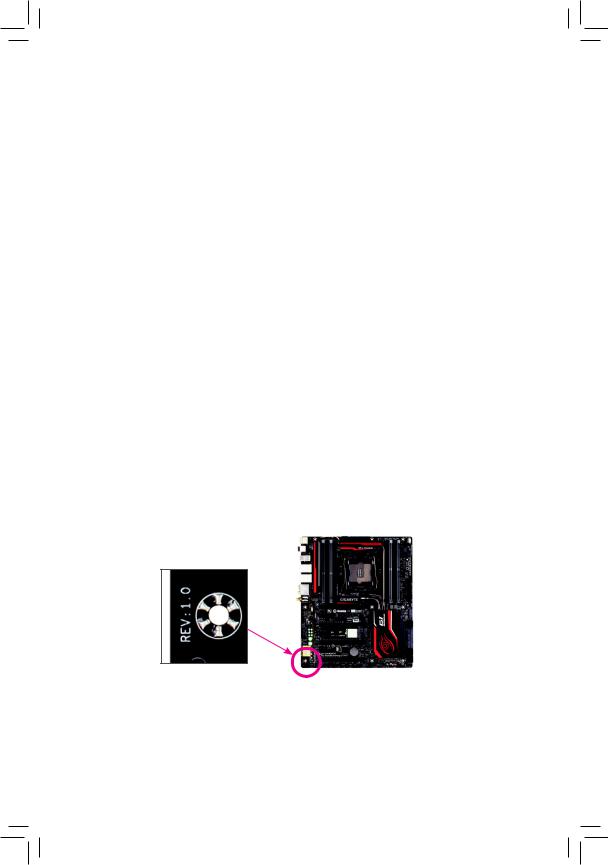
Copyright
© 2016 GIGA-BYTE TECHNOLOGY CO., LTD. All rights reserved.
The trademarks mentioned in this manual are legally registered to their respective owners.
Disclaimer
Information in this manual is protected by copyright laws and is the property of GIGABYTE.
Changes to the specifications and features in this manual may be made by GIGABYTE without prior notice.
No part of this manual may be reproduced, copied, translated, transmitted, or published in any form or by any means without GIGABYTE's prior written permission.
Documentation Classifications
In order to assist in the use of this product, GIGABYTE provides the following types of
documentations:
For quick set-up of the product, read the Quick Installation Guide included with the product.For detailed product information, carefully read the User's Manual.
For product-related information, check on our website at: http://www.gigabyte.com
Identifying Your Motherboard Revision
The revision number on your motherboard looks like this: "REV: X.X." For example, "REV: 1.0" means the revision of the motherboard is 1.0. Check your motherboard revision before updating motherboard BIOS, drivers, or when looking for technical information.
Example:

Table of Contents
Box Contents.................................................................................................................... |
|
|
6 |
Optional Items.................................................................................................................. |
|
6 |
|
GA-X99-UD4 Motherboard Layout................................................................................... |
7 |
||
GA-X99-UD4 Motherboard Block Diagram...................................................................... |
8 |
||
Chapter 1 Hardware Installation...................................................................................... |
9 |
||
1-1 |
Installation Precautions..................................................................................... |
9 |
|
1-2 |
Product Specifications.................................................................................... |
10 |
|
1-3 Installing the CPU and CPU Cooler................................................................ |
13 |
||
|
1-3-1 |
Installing the CPU................................................................................................... |
13 |
|
1-3-2 Installing the CPU Cooler........................................................................................ |
15 |
|
1-4 |
Installing the Memory...................................................................................... |
16 |
|
|
1-4-1 4 Channel Memory Configuration........................................................................... |
16 |
|
|
1-4-2 |
Installing a Memory................................................................................................. |
17 |
1-5 Installing an Expansion Card.......................................................................... |
18 |
||
1-6 Setting up AMD CrossFire™/NVIDIA® SLI™ Configuration............................... |
19 |
||
1-7 |
Back Panel Connectors.................................................................................. |
21 |
|
1-8 Installing the I/O Shield................................................................................... |
22 |
||
1-9 |
Internal Connectors........................................................................................ |
23 |
|
Chapter 2 BIOS Setup................................................................................................... |
37 |
||
2-1 |
Startup Screen................................................................................................ |
38 |
|
2-2 |
The Main Menu............................................................................................... |
39 |
|
2-3 |
M.I.T................................................................................................................ |
42 |
|
2-4 |
System Information......................................................................................... |
54 |
|
2-5 |
BIOS Features................................................................................................ |
55 |
|
2-6 |
Peripherals...................................................................................................... |
58 |
|
2-7 |
Chipset............................................................................................................ |
60 |
|
2-8 |
Power Management........................................................................................ |
63 |
|
2-9 |
Save & Exit..................................................................................................... |
65 |
|
Chapter 3 Configuring SATA Hard Drive(s)................................................................... |
67 |
||
3-1 |
Configuring SATA Controllers......................................................................... |
67 |
|
3-2 Installing the SATA RAID/AHCI Driver and Operating System....................... |
79 |
||
- 4 -

Chapter 4 Drivers Installation........................................................................................ |
83 |
|
4-1 |
Chipset Drivers............................................................................................... |
83 |
4-2 |
Application Software....................................................................................... |
84 |
4-3 |
Information...................................................................................................... |
84 |
Chapter 5 Unique Features........................................................................................... |
85 |
||
5-1 |
BIOS Update Utilities...................................................................................... |
85 |
|
|
5-1-1 |
Updating the BIOS with the Q-Flash Utility............................................................. |
85 |
|
5-1-2 |
Updating the BIOS with the @BIOS Utility.............................................................. |
88 |
|
5-1-3 |
Using Q-Flash Plus................................................................................................. |
89 |
5-2 |
APP Center..................................................................................................... |
90 |
|
|
5-2-1 |
EasyTune................................................................................................................ |
91 |
|
5-2-2 |
System Information Viewer..................................................................................... |
92 |
|
5-2-3 |
EZ Setup................................................................................................................. |
93 |
|
5-2-4 |
Fast Boot................................................................................................................. |
96 |
|
5-2-5 |
Smart TimeLock...................................................................................................... |
97 |
|
5-2-6 |
Smart Recovery 2................................................................................................... |
98 |
|
5-2-7 |
USB Blocker.......................................................................................................... |
100 |
|
5-2-8 |
Ambient LED......................................................................................................... |
101 |
|
5-2-9 |
V-Tuner.................................................................................................................. |
102 |
|
5-2-10 |
Smart Switch......................................................................................................... |
103 |
|
5-2-11 |
Cloud Station Server............................................................................................. |
104 |
Chapter 6 Appendix..................................................................................................... |
|
111 |
6-1 Configuring Audio Input and Output............................................................... |
111 |
|
6-1-1 |
Configuring 2/4/5.1/7.1-Channel Audio................................................................. |
111 |
6-1-2 |
Configuring S/PDIF Out........................................................................................ |
113 |
6-1-3 |
Configuring Microphone Recording....................................................................... |
114 |
6-1-4 Using the Sound Recorder.................................................................................... |
116 |
|
6-2 Troubleshooting............................................................................................ |
117 |
|
6-2-1 |
Frequently Asked Questions ................................................................................ |
117 |
6-2-2 |
Troubleshooting Procedure................................................................................... |
118 |
Regulatory Statements............................................................................................ |
120 |
|
Contact Us............................................................................................................... |
|
127 |
- 5 -

Box Contents
55 GA-X99-UD4 motherboard
55 Motherboard driver disk
55 User's Manual
55 Quick Installation Guide
55 Four SATA cables
55 I/O Shield
55 One 2-Way SLI bridge connector
55 Two 3-Way SLI bridge connectors (GC-3SLI-X99 and GC-3SLI) 55 One 4-Way SLI bridge connector
55 One 2-Way CrossFire bridge connector
55 One 1 to 3 power cable (2x4 ATX 12V)
The box contents above are for reference only and the actual items shall depend on the product package you obtain. The box contents are subject to change without notice.
Optional Items
2-port USB 2.0 bracket (Part No. 12CR1-1UB030-6*R)eSATA bracket (Part No. 12CF1-3SATPW-4*R)
3.5" Front Panel with 2 USB 3.0/2.0 ports (Part No. 12CR1-FPX582-2*R)
- 6 -
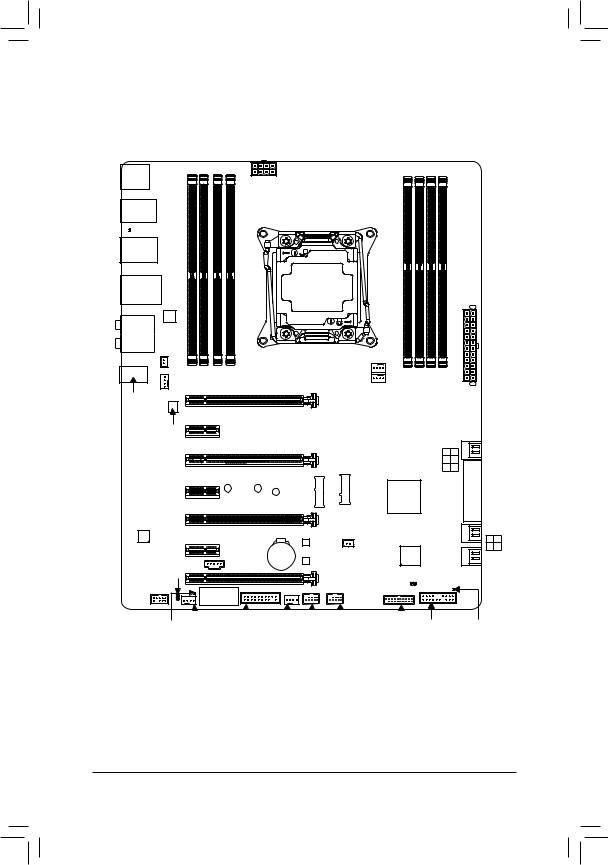
GA-X99-UD4 Motherboard Layout
KB_MS
R_USB
FBIOS_LED |
|
R_USB30 |
|
USB30_LAN |
uPD720210Renesas® |
|
DDR4_4_2B
DDR4_3_1B
DDR4_2_2A
DDR4_1_1A
ATX_12V_2X4
LGA2011-3
AUDIO |
CON1 |
|
|
GA-X99-UD4 |
|
|
LED |
|
|
CPU_FAN |
|
|
|
|
|
SYS_FAN1 |
CPU_OPT |
ANTENNA_BRACKET |
PCIE_1 |
|
|
PCIE_5 |
|
Intel® GbE LAN |
|
|
DDR4_8_2D DDR4_7_1D DDR4_6_2C DDR4_5_1C
ATX
PCIE_4 |
|
M2 10G |
|
|
|
PCIE_6 |
WIFI |
|
|
Intel® X99 |
|
|
M2 |
|
PCIE_2 |
|
|
|
|
CODEC
1 0 |
|
2 4 |
|
3 5 |
EXPRESS |
SATA 3 |
|
|
SATA_ |
|
PCIE_7 |
|
B_BIOS |
LED_CON2 |
|
|
|
|
iTE® |
||
|
|
BAT |
|
|
|
|
THB_C |
M_BIOS |
|
Super I/O |
|
SPDIF_O |
|
|
|||
|
|
PCIE_3 |
|
CLR_CMOS |
|
|
|
|
|
||
F_AUDIO |
ATX4P |
|
|
|
|
|
|
|
|
|
3 1 sSATA 3 2 0
System Temperature SYS_ |
|
FAN2 |
|
|
SYS_ |
|
FAN3 F |
|
|
|
|
|
|
|
TPM |
|
_USB1 F |
_USB2 |
F_USB30 |
F_PANEL |
System Temperature |
||||||
Sensor 2 |
|
|
|
|
|
|
|
|
|
|
Sensor 1 |
||
- 7 -
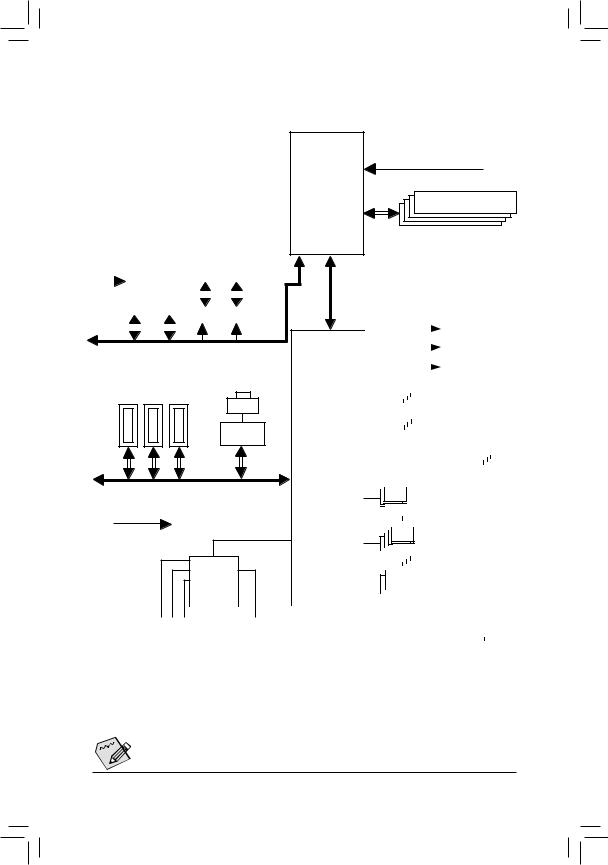
GA-X99-UD4 Motherboard Block Diagram
|
|
|
|
|
|
|
1 PCI Express x16 |
2 |
PCI |
Express x8 |
||||||||||||||
|
1 PCI |
|
|
1 PCI |
|
|
|
|
|
|
|
|
|
|
|
|
|
|
|
|
||||
|
|
|
|
|
|
|
|
|
|
|
|
|
|
|
|
|||||||||
PCI Express x16 |
Express x8 |
|
|
|
|
|
|
|
|
|
|
|
|
|
||||||||||
|
|
|
|
|
|
|
|
|
|
|
|
|
|
|
or |
|
|
|
|
|
|
|
|
|
|
|
|
|
|
|
|
|
|
|
|
|
|
|
|
|
|
|
|
|
|
|
|
|
|
PCIe CLK |
|
|
|
|
|
|
|
|
|
|
|
|
|
|
|
|
|
|
|
|
|
|
|
|
(100 MHz) |
|
|
|
|
|
|
|
|
|
|
|
|
|
|
|
|
|
|
|
|
|
|
|
|
|
|
|
|
|
|
|
|
|
|
|
|
|
|
|
|
|
|
|
|
|
|
|
|
|
|
|
|
|
|
|
|
|
|
|
|
|
|
|
|
x16 |
|
|
|
|
x16 |
||||
|
|
|
|
|
|
|
|
|
|
|
|
|
|
|
||||||||||
|
|
|
|
|
|
|
|
|
|
|
|
|
|
|
|
|
|
|
|
|
|
|
|
|
|
|
|
|
|
|
|
|
|
|
|
|
|
|
|
Switch |
|
|
|||||||
|
|
|
x16 |
|
|
x8 |
|
|
|
|
|
|
|
|||||||||||
|
|
|
|
|
|
|
|
|
|
|
|
|
|
|
|
|
|
|
|
|||||
PCI Express Bus
3 PCI Express x1
|
|
|
Intel® GbE |
|
|
|
LAN |
x1 |
x1 |
x1 |
x1 |
PCI Express Bus
PCIe CLK
(100 MHz)
CODEC
LGA2011-3
CPU
DMI 2.0
Intel® X99
CPU CLK+/- (100 MHz)
DDR4 2133/1866/1600/1333 MHz
4 Channel Memory
|
|
|
|
|
|
|
|
|
|
|
|
|
|
|
|
|
|
|
|
|
|
|
|
|
|
|
|
|
|
|
|
|
|
|
|
|
|
|
|
|
|
|
|
|
|
|
|
|
|
|
|
|
|
|
|
|
|
|
|
|
|
|
|
|
|
|
|
|
|
|
|
|
|
|
|
|
|
|
|
|
|
|
|
|||||||||
|
|
|
|
|
|
|
|
|
|
|
|
|
|
|
|
M.2 |
|
|
|
|||||||||||
|
|
|
|
|
|
|
|
|
|
or |
|
|
|
|
|
|||||||||||||||
|
|
Switch |
|
|
|
|
|
|
SATA Express |
|||||||||||||||||||||
|
|
|
|
|
|
|
||||||||||||||||||||||||
|
|
|
|
|
|
|
|
|
|
or |
|
|
|
|
2 SATA 6Gb/s |
|||||||||||||||
|
|
|
|
|
|
|
|
|
|
|
|
|
|
|||||||||||||||||
|
|
|
|
|
|
|
|
|
|
|
|
|
|
|
|
|
|
|||||||||||||
|
|
|
|
|
|
|
|
|
|
4 SATA 6Gb/s |
||||||||||||||||||||
|
|
|
|
|
|
|
|
|
|
4 SATA 6Gb/s |
||||||||||||||||||||
|
|
|
|
|
|
|
|
|
|
|
|
|
|
|
|
|
|
|
|
|
|
|
|
|
|
|
|
|
|
|
|
|
|
|
|
Renesas® |
|
|
|
|
|
|
|
|
|
|
|
|
|
|
|
||||||||||
|
uPD720210 Hub |
|
|
|
|
|
|
|
|
|
|
|
|
|
|
|
||||||||||||||
|
|
|
|
|
|
|
|
|
|
|
|
|
|
|
|
|||||||||||||||
|
4 |
|
|
|
3.0/2.0 |
|
|
|
||||||||||||||||||||||
|
USB |
|||||||||||||||||||||||||||||
|
|
|
|
|
|
|
|
|
|
|
|
|
|
|
|
|||||||||||||||
|
|
|
|
|
|
|
|
|
|
|
|
|
|
|
|
|
|
|
|
|
|
|
|
|
|
|
|
|
|
|
|
|
|
|
|
|
|
|
|
|
|
|
|
|
|
|
|
|
|
|
|
|
|
|
|
|
|
|
|
|
|
|
|
|
|
|
|
|
|
|
|
|
|
|
|
|
|
|
|
|
|
|
|
|
|
|
|
|
|
|
|
|
|
|
|
|
|
|
|
|
|
|
|
|
|
|
|
|
|
|
|
|
|
|
|
|
|
|
|
|
|
|
|
|
|
|
|
|
|
|
|
|
|
|
|
|
|
|
|
|
|
|
|
|
|
|
|
|
|
|
|
|
|
|
|
|
|
|
|
|
|
|
|
|
|
|
|
|
|
|
|
|
|
|
|
|
|
|
|
|
|
|
|
|
|
|
|
|
|
|
|
|
|
|
|
|
|
|
|
|
|
|
|
|
|
|
|
|
|
|
|
|
|
|
|
|
|
|
|
|
|
|
|
|
|
|
|
|
|
|
|
|
|
|
|
|
|
|
|
|
|
|
|
|
|
|
|
|
|
|
|
|
|
|
|
|
|
|
|
|
|
|
|
|
|
|
|
|
|
|
|
|
|
|
|
|
|
|
|
|
|
|
|
|
|
|
|
|
|
|
|
|
|
|
|
|
|
|
|
|
|
|
|
|
|
|
|
|
|
|
|
|
|
|
|
|
|
|
|
|
|
|
|
|
|
|
|
|
|
|
|
|
|
|
|
|
|
|
|
|
|
|
|
|
|
|
|
|
|
|
|
|
|
|
|
|
|
|
|
|
|
|
|
|
|
|
|
|
|
|
|
|
|
|
|
|
|
|
|
|
|
|
|
|
|
|
|
|
|
|
|
|
|
|
|
|
|
|
|
|
|
|
|
|
|
|
|
|
|
|
|
|
|
|
|
|
|
|
|
|
|
|
|
|
|
|
|
|
|
|
|
|
|
|
|
|
|
|
|
|
|
|
|
|
|
|
|
|
|
|
|
|
|
|
|
|
|
|
|
|
|
|
|
|
|
|
|
|
|
|
|
|
|
|
|
|
|
|
|
|
|
|
|
|
|
|
|
|
|
|
|
|
|
|
|
|
|
|
|
|
|
|
|
|
|
|
|
|
|
|
|
|
|
|
|
|
|
|
|
|
|
|
|
|
|
|
|
|
|
|
|
|
|
|
|
|
|
|
|
|
|
Out Out Out |
|
|
|
|
|
Out |
|
LPC Bus |
|
|
|
|
|
|
|
|
|
|
|
|
|
|
|
|
|||||
MIC |
Out In |
iTE® |
|
|
|
|
||||||||
|
Line |
|
|
Super I/O |
|
|
|
|
||||||
|
|
|
|
|
|
|
||||||||
Speaker Speaker Speaker |
|
|
|
S/PDIF |
|
|
|
|
|
|
|
|||
|
|
Line |
|
|
|
|
|
|
|
|||||
|
|
|
|
|
|
|
|
|
|
|
|
|||
Rear Center/Subwoofer Side |
|
|
|
|
|
|
|
|
|
|
|
|
|
|

 For detailed product information/limitation(s), refer to "1-2 Product Specifications."
For detailed product information/limitation(s), refer to "1-2 Product Specifications."
- 8 -

Chapter 1 Hardware Installation
1-1 Installation Precautions
The motherboard contains numerous delicate electronic circuits and components which can become damaged as a result of electrostatic discharge (ESD). Prior to installation, carefully read the user's manual and follow these procedures:
•• Prior to installation, make sure the chassis is suitable for the motherboard.
•• Prior to installation, do not remove or break motherboard S/N (Serial Number) sticker or warranty sticker provided by your dealer. These stickers are required for warranty validation.
•• Always remove the AC power by unplugging the power cord from the power outlet before installing or removing the motherboard or other hardware components.
•• When connecting hardware components to the internal connectors on the motherboard, make sure they are connected tightly and securely.
•• When handling the motherboard, avoid touching any metal leads or connectors.
•• It is best to wear an electrostatic discharge (ESD) wrist strap when handling electronic components such as a motherboard, CPU or memory. If you do not have an ESD wrist strap, keep your hands dry and first touch a metal object to eliminate static electricity.
•• Prior to installing the motherboard, please have it on top of an antistatic pad or within an electrostatic shielding container.
•• Before unplugging the power supply cable from the motherboard, make sure the power supply has been turned off.
•• Before turning on the power, make sure the power supply voltage has been set according to the local voltage standard.
•• Before using the product, please verify that all cables and power connectors of your hardware components are connected.
•• To prevent damage to the motherboard, do not allow screws to come in contact with the motherboard circuit or its components.
•• Make sure there are no leftover screws or metal components placed on the motherboard or within the computer casing.
•• Do not place the computer system on an uneven surface.
•• Do not place the computer system in a high-temperature environment.
•• Turning on the computer power during the installation process can lead to damage to system components as well as physical harm to the user.
•• If you are uncertain about any installation steps or have a problem related to the use of the product, please consult a certified computer technician.
- 9 - |
Hardware Installation |

1-2 Product Specifications |
|
|
|
CPU |
Support for Intel® Core™ i7 processors in the LGA2011-3 package |
|
(Go to GIGABYTE's website for the latest CPU support list.) |
|
L3 cache varies with CPU |
Chipset |
Intel® X99 Express Chipset |
Memory |
8 x DDR4 DIMM sockets supporting up to 128 GB of system memory |
* Due to a Windows 32-bit operating system limitation, when more than 4 GB of physical memory is installed, the actual memory size displayed will be less than the size of the physical memory installed.
4 channel memory architecture
Support for DDR4 2133/1866/1600/1333 MHz memory modules
Support for non-ECC memory modules
Support for Extreme Memory Profile (XMP) memory modules
Support for RDIMM 1Rx8 memory modules (operate in non-ECC mode)
|
|
(Go to GIGABYTE's website for the latest supported memory speeds and |
|
|
memory modules.) |
Audio |
|
Realtek® ALC1150 codec |
|
High Definition Audio |
|
|
|
2/4/5.1/7.1-channel |
|
Support for S/PDIF Out |
|
LAN |
|
Intel® GbE LAN chip (10/100/1000 Mbit) |
Expansion Slots |
|
2 x PCI Express x16 slots, running at x16 (PCIE_1, PCIE_2) |
* For optimum performance, if only one PCI Express graphics card is to be installed, be sure to install it in the PCIE_1 slot; if you are installing two PCI Express graphics cards, it is recommended that you install them in the PCIE_1 and PCIE_2 slots.
2 x PCI Express x16 slots, running at x8 (PCIE_3, PCIE_4)
* The PCIE_4 slot shares bandwidth with the PCIE_1 slot. When the PCIE_4 slot is populated, the PCIE_1 slot will operate at up to x8 mode.
* When an i7-5820K CPU is installed, the PCIE_2 slot operates at up to x8 mode and the PCIE_3 operates at up to x4 mode.
(All PCI Express x16 slots conform to PCI Express 3.0 standard.)
3 x PCI Express x1 slots
(The PCI Express x1 slots conform to PCI Express 2.0 standard.)
1 x M.2 Socket 1 connector for the wireless communication module (M2_WIFI)
Multi-Graphics |
Support for 4-Way/3-Way/2-Way AMD CrossFire™/NVIDIA® SLI™ technology |
|
|
Technology |
|
* The 4-Way NVIDIA® SLI™ configuration is not supported when an i7-5820K CPU is |
|
|
|
installed.Tosetupa3-WaySLIconfiguration,referto"1-6SettingupAMDCrossFire™/ |
|
|
|
NVIDIA® SLI™ Configuration." |
|
Storage Interface |
Chipset: |
|
|
|
- |
1 x M.2 Socket 3 connector (M2_10G) |
|
|
- |
1 x SATA Express connector |
|
|
- |
6 x SATA 6Gb/s connectors (SATA3 0~5) |
|
|
- |
Support for RAID 0, RAID 1, RAID 5, and RAID 10 |
|
|
|
* Only AHCI mode is supported when an M.2 PCIe SSD or a SATA Express device is |
|
|
|
installed. |
|
|
(M2_10G, SATA Express, and SATA3 4/5 connectors can only be used one at a |
||
|
time. The SATA3 4/5 connectors will become unavailable when an M.2 SSD is |
||
|
installed in the M2_10G connector.) |
||
|
|
|
|
Hardware Installation |
|
- 10 - |
|

Storage Interface |
|
Chipset: |
|
|
|
- |
4 x SATA6Gb/s connectors (sSATA3 0~3), supporting IDE andAHCI modes |
|
|
|
only |
|
|
(An operating system installed on the SATA3 0~5 ports cannot be used on the |
|
|
|
sSATA3 0~3 ports.) |
|
USB |
|
Chipset: |
|
|
|
- |
4 x USB 3.0/2.0 ports (2 ports on the back panel, 2 ports available through |
|
|
|
the internal USB header) |
|
|
- |
8 x USB 2.0/1.1 ports (4 ports on the back panel, 4 ports available through |
|
|
|
the internal USB headers) |
|
Chipset + Renesas® uPD720210 USB 3.0 Hub: |
|
|
- |
4 x USB 3.0/2.0 ports on the back panel |
Internal |
1 x 24-pin ATX main power connector |
|
Connectors |
1 x 8-pin ATX 12V power connector |
|
|
1 x PCIe power connector |
|
|
1 x I/O shield audio LED power connector |
|
|
1 x heatsink LED power connector |
|
|
1 x M.2 Socket 3 connector |
|
|
1 x SATA Express connector |
|
|
10 x SATA 6Gb/s connectors |
|
|
1 x CPU fan header |
|
|
1 x water cooling fan header (CPU_OPT) |
|
|
3 x system fan headers |
|
|
1 x front panel header |
|
|
1 x front panel audio header |
|
|
1 x USB 3.0/2.0 header |
|
|
2 x USB 2.0/1.1 headers |
|
|
1 x Trusted Platform Module (TPM) header |
|
|
1 x Thunderbolt add-in card connector |
|
|
1 x Clear CMOS jumper |
|
Back Panel |
1 x PS/2 keyboard port |
|
Connectors |
1 x PS/2 mouse port |
|
|
6 x USB 3.0/2.0 ports |
|
|
4 x USB 2.0/1.1 ports |
|
|
1 x RJ-45 port |
|
|
1 x optical S/PDIF Out connector |
|
|
5 x audio jacks (Center/Subwoofer Speaker Out, Rear Speaker Out, Line In, |
|
|
Line Out, Mic In) |
|
|
2 x Wi-Fi antenna connector holes |
|
I/O Controller |
iTE® I/O Controller Chip |
|
- 11 - |
Hardware Installation |

Hardware |
|
System voltage detection |
||
Monitor |
|
CPU/System/Chipset temperature detection |
||
|
CPU/CPU OPT/System fan speed detection |
|||
|
|
CPU/System/Chipset overheating warning |
||
|
CPU/CPU OPT/System fan fail warning |
|||
|
CPU/CPU OPT/System fan speed control |
|||
|
|
|
* Whether the fan speed control function is supported will depend on the cooler you |
|
|
|
|
install. |
|
BIOS |
|
2 x 128 Mbit flash |
||
|
Use of licensed AMI UEFI BIOS |
|||
|
Support for DualBIOS™ |
|||
|
Support for Q-Flash Plus |
|||
|
PnP 1.0a, DMI 2.7, WfM 2.0, SM BIOS 2.7, ACPI 5.0 |
|||
Unique Features |
|
Support for APP Center |
||
|
|
|
* Available applications in APP Center may differ by motherboard model. Supported |
|
|
|
|
functions of each application may also differ depending on motherboard |
|
|
|
|
specifications. |
|
|
|
- |
@BIOS |
|
|
|
- |
Ambient LED |
|
|
|
- |
EasyTune |
|
|
|
- |
EZ Setup |
|
|
|
- |
Fast Boot |
|
|
|
- |
Cloud Station |
|
|
|
- |
ON/OFF Charge |
|
|
|
- |
Smart TimeLock |
|
|
|
- |
Smart Recovery 2 |
|
|
|
- |
System Information Viewer |
|
|
|
- |
USB Blocker |
|
|
|
- |
V-Tuner |
|
|
|
Support for Q-Flash |
||
|
Support for Smart Switch |
|||
|
Support for Xpress Install |
|||
Bundled |
|
Norton® Internet Security (OEM version) |
||
Software |
|
Intel® Smart Response Technology |
||
|
|
cFosSpeed |
||
Operating |
Support for Windows 8.1/8/7 |
|||
System |
||||
|
|
|
||
Form Factor |
|
ATX Form Factor; 30.5cm x 24.4cm |
||
*GIGABYTE reserves the right to make any changes to the product specifications and product-related information without prior notice.
*Please visit the Support & Downloads\Utility page on GIGABYTE's website to check the supported operating system(s) for the software listed in the "Unique Features" and "Bundled Software" columns.
Hardware Installation |
- 12 - |
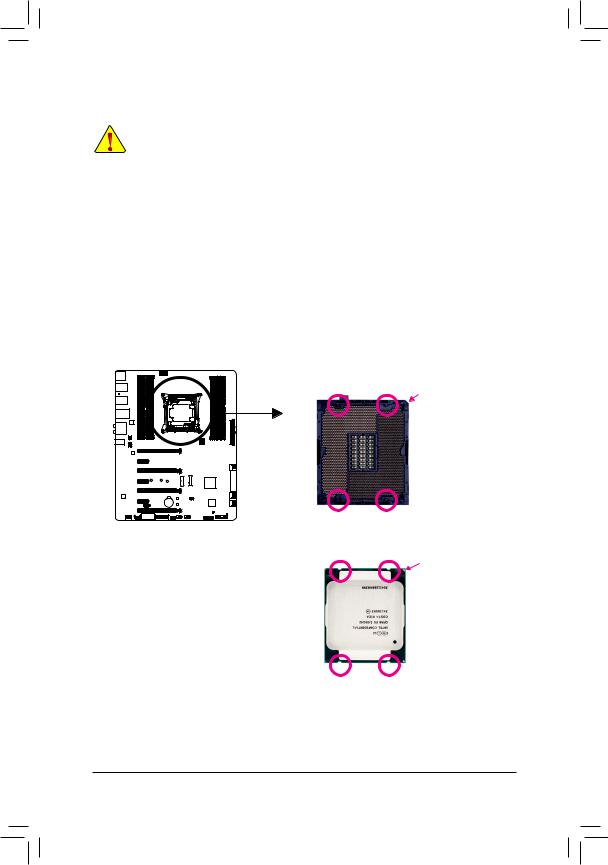
1-3 |
Installing the CPU and CPU Cooler |
|
|
Read the following guidelines before you begin to install the CPU: |
|
|
•• |
Make sure that the motherboard supports the CPU. |
|
|
(Go to GIGABYTE's website for the latest CPU support list.) |
|
•• |
Always turn off the computer and unplug the power cord from the power outlet before installing the |
|
|
CPU to prevent hardware damage. |
|
•• |
Locate the pin one of the CPU. The CPU cannot be inserted if oriented incorrectly. (Or you may |
|
|
locate the notches on both sides of the CPU and alignment keys on the CPU socket.) |
|
•• |
Apply an even and thin layer of thermal grease on the surface of the CPU. |
|
•• |
Do not turn on the computer if the CPU cooler is not installed, otherwise overheating and damage |
|
|
of the CPU may occur. |
|
•• |
Set the CPU host frequency in accordance with the CPU specifications. It is not recommended |
|
|
that the system bus frequency be set beyond hardware specifications since it does not meet the |
|
|
standard requirements for the peripherals. If you wish to set the frequency beyond the standard |
|
|
specifications, please do so according to your hardware specifications including the CPU, graphics |
|
|
card, memory, hard drive, etc. |
1-3-1 Installing the CPU
A. Locate the alignment keys on the motherboard CPU socket and the notches on the CPU.
LGA2011-3 CPU Socket
Alignment Key |
Alignment Key |
Pin One Corner of |
|
|
|
|
|
the CPU Socket |
Alignment Key Alignment Key
LGA2011-3 CPU
Notch Notch
Triangle Pin One
Marking on the CPU
Notch Notch
- 13 - |
Hardware Installation |
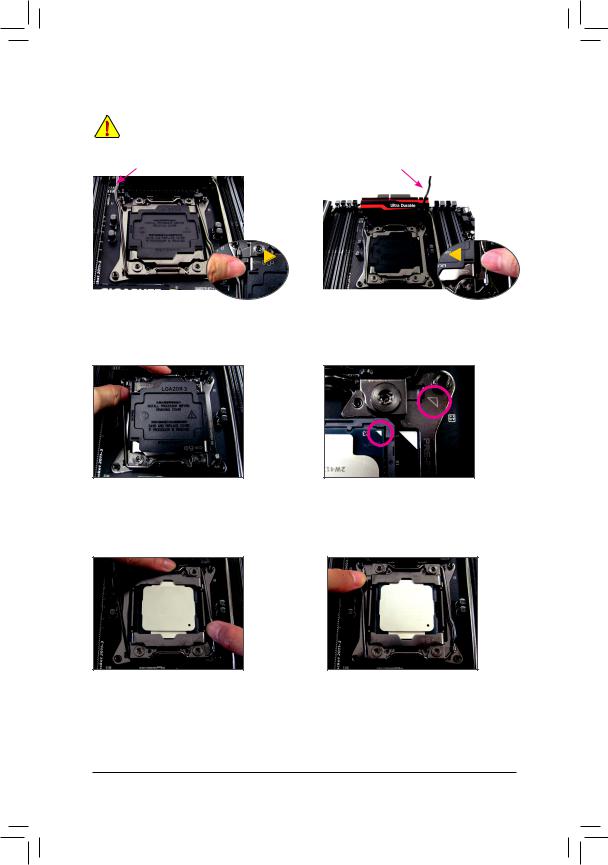
B. Follow the steps below to correctly install the CPU into the motherboard CPU socket.
•• Before installing the CPU, make sure to turn off the computer and unplug the power cord from the power outlet to prevent damage to the CPU.
•• To protect the socket contacts, do not remove the protective plastic cover unless the CPU is inserted into the CPU socket. Save the cover properly and replace it if the CPU is removed.
Lever A |
|
|
|
Lever B |
|
|
|
|
|
|
|
|
|
|
|
|
|
|
|
|
|
|
|
|
|
|
|
Step 1:
Push the lever closest to the "unlock" mark " "
"
(below referred as leverA) down and away from the socket to release it.
Step 3:
Gently press lever A to allow the load plate to rise. Open the load plate. Note: DO NOT touch the socket contacts after the load plate is opened.
Step 5:
Once the CPU is properly inserted, carefully replace the load plate. Then secure lever B under its retention tab.
Step 2:
Push the lever closest to the "lock" mark " "
"
(below referred as lever B) down and away from the socket. Then lift the lever.
Step 4:
Hold the CPU with your thumb and index fingers. Align the CPU pin one mark (triangle) with the triangle mark on metal socket frame and carefully insert the CPU into the socket vertically.
Step 6:
Finally, secure lever A under its retention tab to complete the installation of the CPU. Then carefully remove the plastic cover. Save it properly and always replace it when the CPU is not installed.
Hardware Installation |
- 14 - |
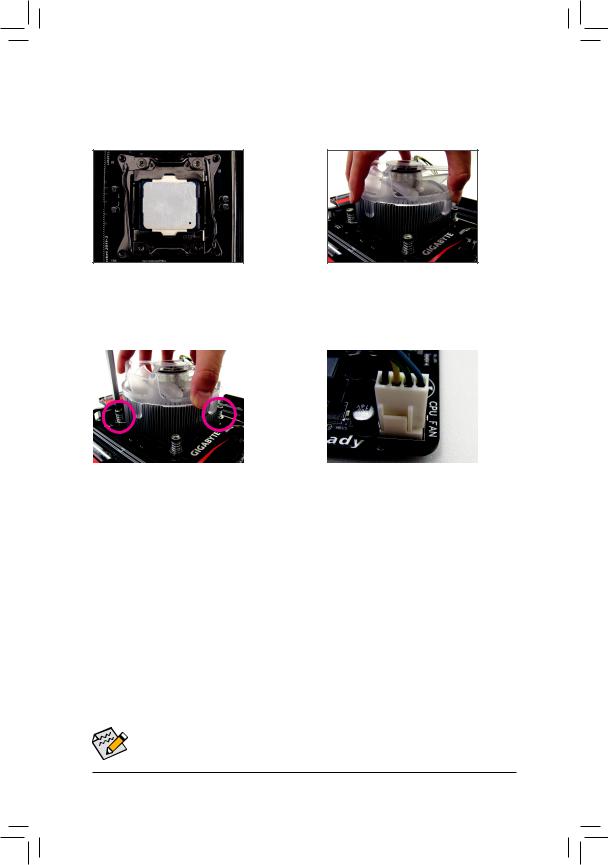
1-3-2 Installing the CPU Cooler
Refer to the steps below to correctly install the CPU cooler on the motherboard. (Actual installation process may differ depending the CPU cooler to be used. Refer to the user's manual for your CPU cooler.)
Step 1: |
Step 2: |
||
Apply an even and thin layer of thermal grease on |
Place the cooler atop the CPU, aligning the four |
||
the surface of the installed CPU. |
mounting screws with the mounting holes on |
||
|
|
the ILM. |
|
|
|
|
|
|
|
|
|
Step 3: |
Step 4: |
Use one hand to hold the cooler and the other to |
Finally, attach the power connector of the CPU |
tighten the screws in a diagonal sequence with a |
cooler to the CPU fan header (CPU_FAN) on the |
screw driver. Begin tightening a screw with a few |
motherboard. |
turns and repeat with the screw diagonally opposite |
|
the one you just tightened. Then do the same to |
|
the other pair. Next, fully tighten the four screws. |
|
 Use extreme care when removing the CPU cooler because the thermal grease/tape between the CPU cooler and CPU may adhere to the CPU. Inadequately removing the CPU cooler may damage the CPU.
Use extreme care when removing the CPU cooler because the thermal grease/tape between the CPU cooler and CPU may adhere to the CPU. Inadequately removing the CPU cooler may damage the CPU.
- 15 - Hardware Installation
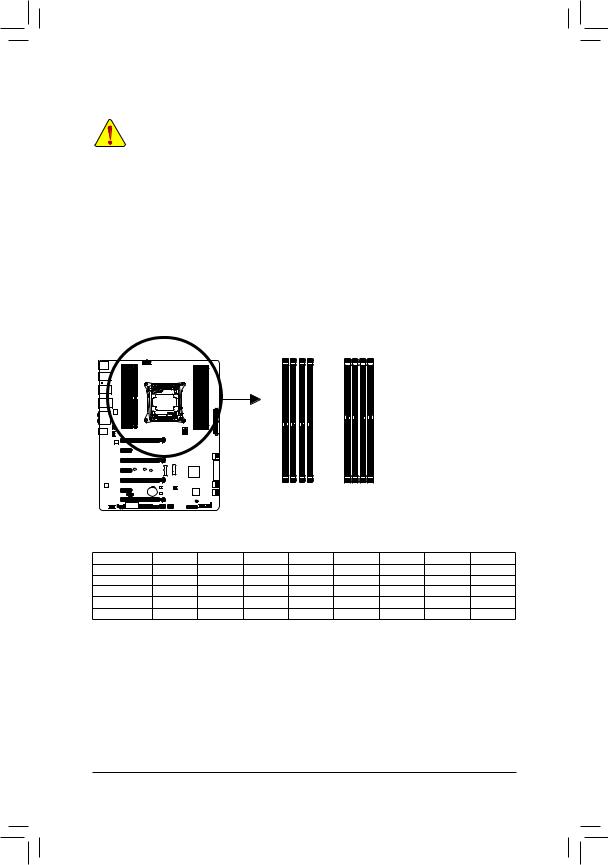
1-4 Installing the Memory
Read the following guidelines before you begin to install the memory:
•• Make sure that the motherboard supports the memory. It is recommended that memory of the same capacity, brand, speed, and chips be used.
(Go to GIGABYTE's website for the latest supported memory speeds and memory modules.)
•• Always turn off the computer and unplug the power cord from the power outlet before installing the memory to prevent hardware damage.
•• Memory modules have a foolproof design. A memory module can be installed in only one direction. If you are unable to insert the memory, switch the direction.
1-4-1 4 Channel Memory Configuration
This motherboard provides eight DDR4 memory sockets and supports 4 Channel Technology. After the memory is installed, the BIOS will automatically detect the specifications and capacity of the memory. The eight DDR4 memory sockets are divided into four channels and each channel has two memory sockets as following:
Channel A: DDR4_1_1A, DDR4_2_2AChannel B: DDR4_3_1B, DDR4_4_2BChannel C: DDR4_5_1C, DDR4_6_2CChannel D: DDR4_7_1D, DDR4_8_2D
2A |
2B |
2D 1D 2C 1C |
1A 1B |
_ _ _ _ |
|
1 _2 |
_4 |
8 7 6 5 |
_ _ 3 |
_ _ _ _ |
|
DDR4 DDR4 DDR4 DDR4_ |
DDR4 DDR4 DDR4 DDR4 |
|
 Refer to the table below for memory installation according to the number of the memory modules you want to install:
Refer to the table below for memory installation according to the number of the memory modules you want to install:
|
|
DDR4_1_1A |
DDR4_2_2A |
DDR4_3_1B |
DDR4_4_2B |
DDR4_8_2D |
DDR4_7_1D |
DDR4_6_2C |
DDR4_5_1C |
1 |
Module |
- - |
- - |
• |
- - |
- - |
- - |
- - |
- - |
2 |
Modules |
- - |
- - |
• |
- - |
- - |
• |
- - |
- - |
4 |
Modules |
• |
- - |
• |
- - |
- - |
• |
- - |
• |
6 |
Modules |
• |
- - |
• |
• |
• |
• |
- - |
• |
8 |
Modules |
• |
• |
• |
• |
• |
• |
• |
• |
Note 1: Wheninstallingthememory,makesuretobeginwiththefirstsocketofeachchannel,suchasDDR4_1_1A,
DDR4_3_1B, DDR4_5_1C, and DDR4_7_1D.
Note 2: If you are using a RDIMM memory, make sure it is a 1Rx8 one.
Note 3: To ensure memory compatibility, we do not recommend that you install RDIMM and UDIMM memory at the same time.
Hardware Installation |
- 16 - |
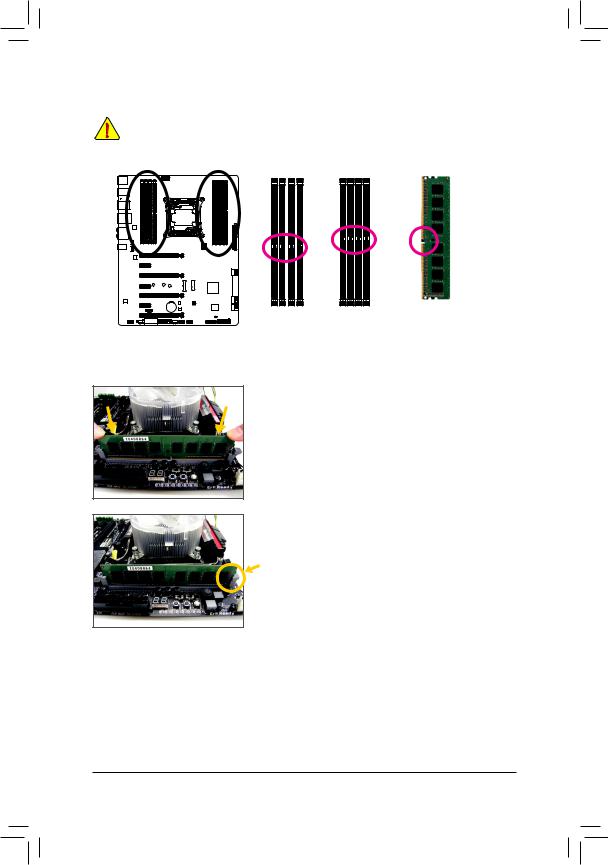
1-4-2 Installing a Memory
Before installing a memory module, make sure to turn off the computer and unplug the power cord from the power outlet to prevent damage to the memory module. DDR4 and DDR3 DIMMs are not compatible to each other or DDR2 DIMMs. Be sure to install DDR4 DIMMs on this motherboard.
Notch
DDR4 DIMM
ADDR4 memory module has a notch, so it can only fit in one direction. Follow the steps below to correctly install your memory modules in the memory sockets.
Step 1:
Note the orientation of the memory module. Spread the retaining clip at the right end of the memory socket. Place the memory module on the socket. As indicated in the picture on the left, place your fingers on the top edge of the memory, push down on the memory and insert it vertically into the memory socket.
Step 2:
The clip at the right end of the socket will snap into place when the memory module is securely inserted.
- 17 - |
Hardware Installation |
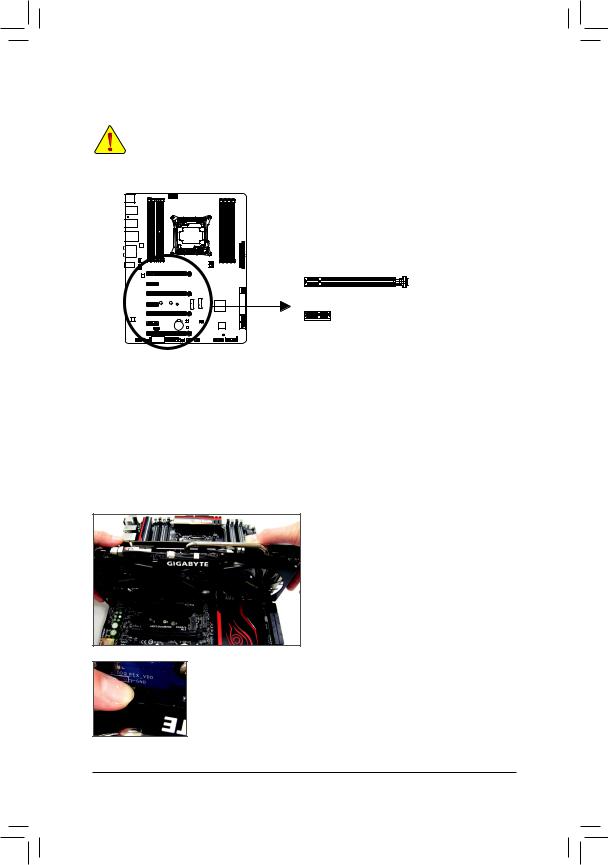
1-5 Installing an Expansion Card
Read the following guidelines before you begin to install an expansion card:
•• Make sure the motherboard supports the expansion card. Carefully read the manual that came with your expansion card.
•• Always turn off the computer and unplug the power cord from the power outlet before installing an expansion card to prevent hardware damage.
PCI Express x16 Slot
PCI Express x1 Slot
Follow the steps below to correctly install your expansion card in the expansion slot.
1.Locate an expansion slot that supports your card. Remove the metal slot cover from the chassis back panel.
2.Align the card with the slot, and press down on the card until it is fully seated in the slot.
3.Make sure the metal contacts on the card are completely inserted into the slot.
4.Secure the card's metal bracket to the chassis back panel with a screw.
5.After installing all expansion cards, replace the chassis cover(s).
6.Turn on your computer. If necessary, go to BIOS Setup to make any required BIOS changes for your expansion card(s).
7.Install the driver provided with the expansion card in your operating system.
Example: Installing and Removing a PCI Express Graphics Card:
•• Installing a Graphics Card:
Gently push down on the top edge of the card until it is fully inserted into the PCI Express slot. Make sure the card is securely seated in the slot and does not rock.
•• Removing the Card:
Gently push back on the lever on the slot and then lift the card straight out from the slot.
Hardware Installation |
- 18 - |
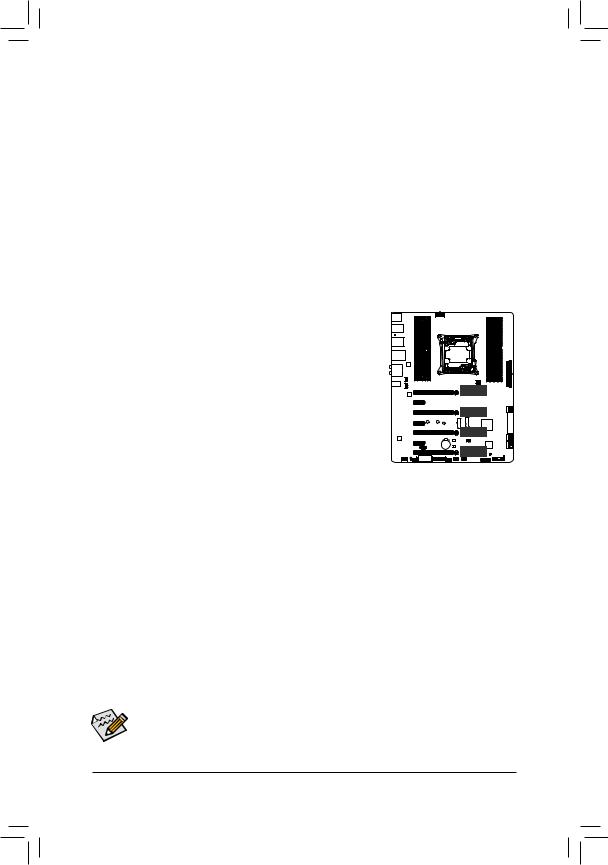
1-6 Setting up AMD CrossFire™/NVIDIA® SLI™ Configuration
A.System Requirements
-- Windows 8.1/8/7 operating system
-- A CrossFire/SLI-supported motherboard with two or more PCI Express x16 slots and correct driver -- CrossFire/SLI-ready graphics cards of identical brand and chip and correct driver
(Current GPUs that support 3-Way/4-Way CrossFire technology include the ATI Radeon™ HD 3800, HD 4800, HD 5800 series, and AMD Radeon™ HD 6800, HD 6900, HD 7800, and HD 7900 series. Current GPUs that support 3-Way/4-Way SLI™ technology include the NVIDIA® 8800 GTX, 8800 Ultra, 9800 GTX,
GTX 260, GTX 280, GTX 470, GTX 480, GTX 570, GTX 580, GTX 590, and GTX 600 series.) For the latest GPU support information, please refer to the AMD/NVIDIA® website.) (Note 1)
-- CrossFire(Note 2)/SLI bridge connectors
-- A power supply with sufficient power is recommended (Refer to the manual of your graphics cards for the power requirement)
B.Connecting the Graphics Cards
Step 1:
Observe the steps in "1-5 Installing an Expansion Card" and install CrossFire/ SLI graphics cards on the PCI Express x16 slots.
Step 2:
Insert the CrossFire(Note 2)/SLI bridge connectors in the CrossFire/SLI gold edge connectors on top of the cards.
Step 3:
Plug the display cable into the graphics card on the PCIE_1 slot.
Refer to the table below when an i7-5960X or i7-5930K CPU is installed:
|
1 Graphics Card |
2 Graphics Cards |
3 Graphics Cards |
4 Graphics Cards |
PCIE_1 |
• |
• |
• |
• |
PCIE_4 |
- - |
- - |
- - |
• |
PCIE_2 |
- - |
• |
• |
• |
PCIE_3 |
- - |
- - |
• |
• |

 To set up a 3-Way SLI configuration, use the GC-3SLI-X99 bridge connector.
To set up a 3-Way SLI configuration, use the GC-3SLI-X99 bridge connector.
PCIE_1
PCIE_4
PCIE_2
PCIE_3
Refer to the table below for setting up a 3-Way SLI configuration with an i7-5820K CPU. Make sure to use the GC-3SLI bridge connector.
|
1 Graphics Card |
2 Graphics Cards |
3 Graphics Cards |
PCIE_1 |
• |
• |
• |
PCIE_4 |
- - |
- - |
• |
PCIE_2 |
- - |
• |
• |
PCIE_3 |
- - |
- - |
- - |
(Note 1) The 4-Way SLI configuration is not supported when an i7-5820K CPU is installed. (Note 2) The bridge connector(s) may be needed or not depending on your graphics cards.
•• Procedure and driver screen for enabling CrossFire/SLI technology may differ by graphics cards and driver  version. Refer to the manual that came with your graphics cards for more information about enabling CrossFire/
version. Refer to the manual that came with your graphics cards for more information about enabling CrossFire/
SLI technology.
•• When two or more graphics cards are installed, we recommend that you connect the power cable from the power supply to the ATX4P connector to ensure system stability.
- 19 - |
Hardware Installation |
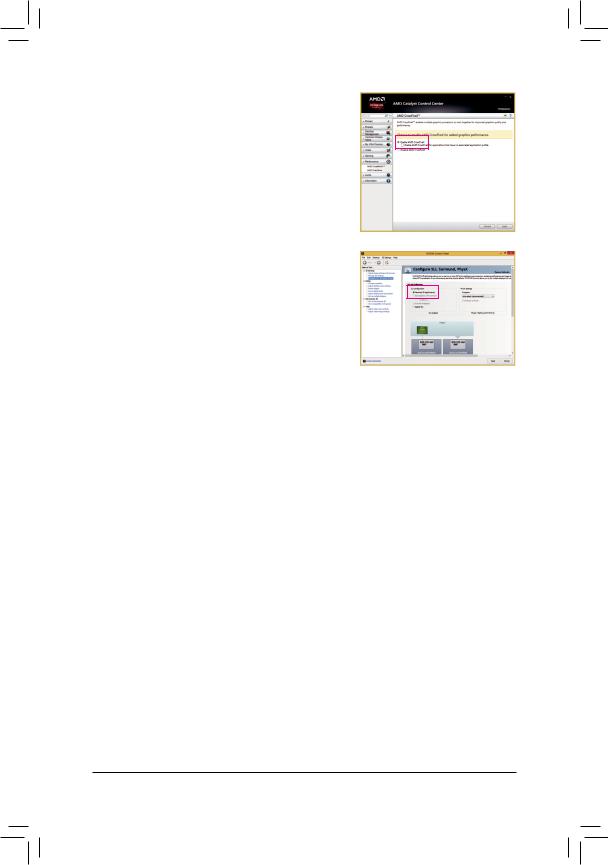
C. Configuring the Graphics Card Driver
C-1. To Enable CrossFire Function
After installing the graphics card driver in the operating system, go to the AMD Catalyst Control Center. Browse to Performance\ AMD CrossFireX™ and ensure the Enable AMD CrossFireX check box is selected. If your system has more than two CrossFire cards, select the GPU combination you want to use and click Apply.
(Available combination options are dependent on the number of graphics cards.)
C-2. To Enable SLI Function
After installing the graphics card driver in the operating system, go to the NVIDIA Control Panel. Browse to the ConfigureSLI,Surround,
Physx screen and ensure Maximize 3D performance is enabled.
Hardware Installation |
- 20 - |
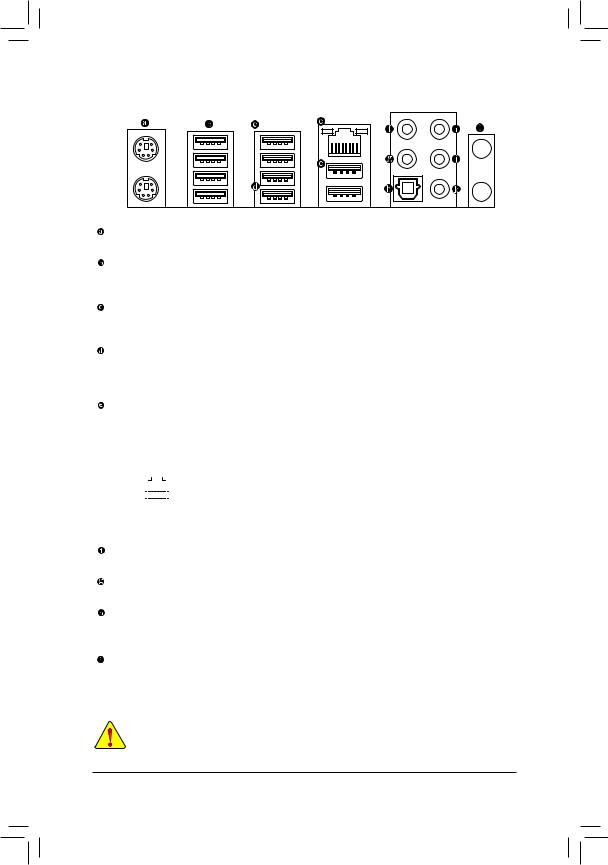
1-7 Back Panel Connectors
PS/2 Keyboard and PS/2 Mouse Port
Usetheupperport(green)toconnectaPS/2mouseandthelowerport(purple)toconnectaPS/2keyboard.
USB 2.0/1.1 Port
The USB port supports the USB 2.0/1.1 specification. Use this port for USB devices such as a USB keyboard/mouse, USB printer, USB flash drive and etc.
USB 3.0/2.0 Port
The USB 3.0 port supports the USB 3.0 specification and is compatible to the USB 2.0/1.1 specification. Use this port for USB devices such as a USB keyboard/mouse, USB printer, USB flash drive and etc.
USB 3.0/2.0 Port (White)
The USB 3.0 port supports the USB 3.0 specification and is compatible to the USB 2.0/1.1 specification. Use this port for USB devices such as a USB keyboard/mouse, USB printer, USB flash drive and etc. Before using Q-Flash Plus, make sure to insert the USB flash drive into this port first.
RJ-45 LAN Port
The Gigabit Ethernet LAN port provides Internet connection at up to 1 Gbps data rate. The following describes the states of the LAN port LEDs.
Connection/ |
|
|
|
|
|
|
|
|
Connection/Speed LED: |
Activity LED: |
|
||||||||
Speed LED |
|
|
|
Activity LED |
|
||||||||||||||
|
|
|
|
|
|
|
|
||||||||||||
|
|
|
|
|
|
|
|
|
|
|
|
|
|
|
State |
Description |
|
State |
Description |
|
|
|
|
|
|
|
|
|
|
|
|
|
|
|
Orange |
1 Gbps data rate |
|
Blinking |
Data transmission or receiving is |
|
|
|
|
|
|
|
|
|
|
|
|
|
|
|
Green |
100 Mbps data rate |
|
|
occurring |
|
|
|
|
|
|
|
|
|
|
|
|
|
|
|
|
|
|||
|
|
|
|
|
|
|
|
|
|
|
|
|
|
|
Off |
10 Mbps data rate |
|
On |
No data transmission or receiving is |
|
|
|
|
|
|
|
|
|
|
|
|
|
|
|
|||||
|
|
|
|
LAN Port |
|||||||||||||||
|
|
|
|
|
|
|
|
occurring |
|||||||||||
|
|
|
|
|
|
|
|
|
|
|
|
|
|
|
|
|
|
|
|
Center/Subwoofer Speaker Out Jack (Orange)
Use this audio jack to connect center/subwoofer speakers in a 5.1/7.1-channel audio configuration.
Rear Speaker Out Jack (Black)
This jack can be used to connect front speakers in a 4/5.1/7.1-channel audio configuration.
Optical S/PDIF Out Connector
This connector provides digital audio out to an external audio system that supports digital optical audio. Before using this feature, ensure that your audio system provides an optical digital audio in connector.
Line In Jack (Blue)
The line in jack. Use this audio jack for line in devices such as an optical drive, walkman, etc.
•• When removing the cable connected to a back panel connector, first remove the cable from your device and then remove it from the motherboard.
•• When removing the cable, pull it straight out from the connector. Do not rock it side to side to prevent an electrical short inside the cable connector.
- 21 - |
Hardware Installation |
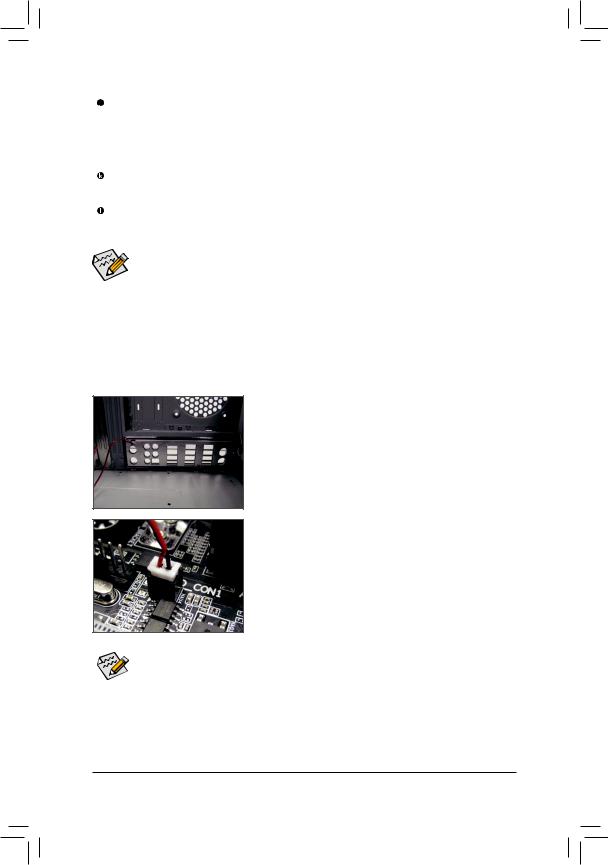
Line Out Jack (Green)
The line out jack. This jack supports audio amplifying function. For better sound quality, it is recommended that you connect your headphone/speaker to this jack (actual effects may vary by the device being used).
Use this audio jack for a headphone or 2-channel speaker. This jack can be used to connect front speakers in a 4/5.1/7.1-channel audio configuration.
Mic In Jack (Pink)
The Mic in jack. Microphones must be connected to this jack.
Wi-Fi Antenna Connector Holes
Secure the antenna connectors, washers, and nuts onto the holes.
The audio jacks can be reconfigured to perform different functions via the audio software (supported functions may vary based on hardware specification). If you install a Side Speaker, you need to retask other audio jack to be Side Speaker out. Only microphones still MUST be connected to the default Mic in jack. Refer to the instructions on setting up a 2/4/5.1/7.1-channel audio configuration in Chapter 6, "Configuring 2/4/5.1/7.1-Channel Audio."
1-8 Installing the I/O Shield
Step 1:
Install the included I/O shield into the chassis. (For actual installation, please refer to the user guide for your chassis.)
Step 2:
Place the motherboard into the chassis, aligning the back panel connectors with the installed I/O shield. Connect the power cable from the I/O shield to the LED_CON1 connector on the motherboard.
For how to turn on/off the I/O shield LED indicators, refer to the instructions on in Chapter 2, "BIOS Setup," "Peripherals," or Chapter 5, "Unique Features," "APP Center\Ambient LED."
Hardware Installation |
- 22 - |

1-9 Internal Connectors
1 |
4 |
|
2 |
7 |
|
5 |
6 |
|
13 |
10 |
|
21 |
|
|
|
|
|
|
|
|
9 |
|
|
|
|
|
|
|
|
11 |
|
20 |
|
|
|
|
|
|
|
|
|
|
|
|
|
|
|
|
|
22 |
|
16 |
|
|
|
|
|
|
|
|
|
15 |
5 |
3 |
19 |
5 |
18 |
8 |
12 |
17 |
14 |
1) |
ATX_12V_2X4 |
12) |
M2_10G |
2) |
ATX |
13) |
M2_WIFI |
3) |
ATX4P |
14) |
F_PANEL |
4) |
CPU_FAN |
15) |
F_AUDIO |
5) |
SYS_FAN1/2/3 |
16) |
SPDIF_O |
6) |
CPU_OPT |
17) |
F_USB30 |
7) |
LED_CON1 |
18) |
F_USB1/F_USB2 |
8) |
LED_CON2 |
19) |
TPM |
9) |
SATA_EXPRESS |
20) |
THB_C |
10) |
SATA3 0/1/2/3/4/5 |
21) |
BAT |
11) |
sSATA3 0/1/2/3 |
22) |
CLR_CMOS |
Read the following guidelines before connecting external devices:
•• First make sure your devices are compliant with the connectors you wish to connect.
•• Before installing the devices, be sure to turn off the devices and your computer. Unplug the power cord from the power outlet to prevent damage to the devices.
•• After installing the device and before turning on the computer, make sure the device cable has been securely attached to the connector on the motherboard.
- 23 - |
Hardware Installation |
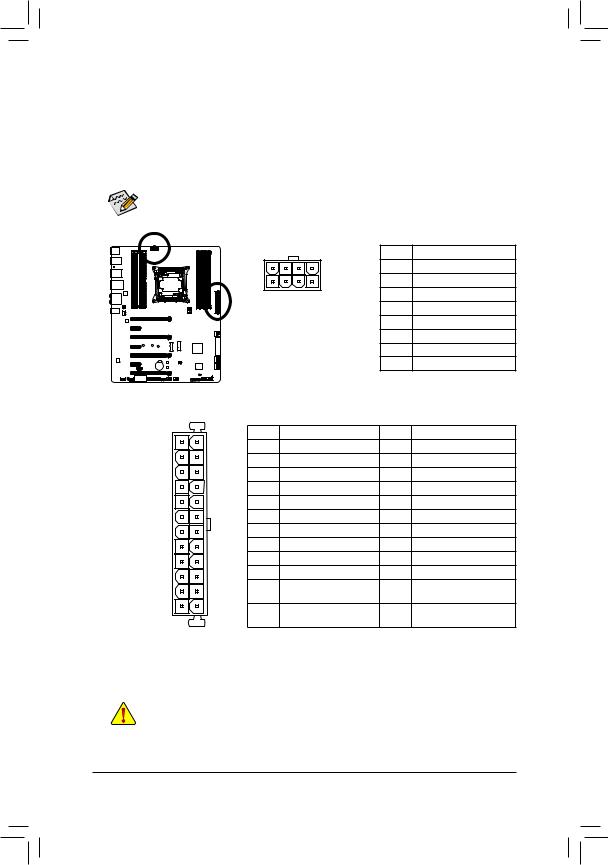
1/2) ATX_12V_2X4/ATX (2x4 12V Power Connector and 2x12 Main Power Connector)
With the use of the power connector, the power supply can supply enough stable power to all the components on the motherboard. Before connecting the power connector, first make sure the power supply is turned off and all devices are properly installed. The power connector possesses a foolproof design. Connect the power supply cable to the power connector in the correct orientation.
The 12V power connector mainly supplies power to the CPU. If the 12V power connector is not connected, the computer will not start.
To meet expansion requirements, it is recommended that a power supply that can withstand high power consumption be used (500W or greater). If a power supply is used that does not provide the required power, the result can lead to an unstable or unbootable system.
12 24
1 |
13 |
ATX
|
|
ATX_12V_2X4: |
||
|
|
Pin No. |
Definition |
|
5 |
8 |
1 |
GND (Only for 2x4-pin 12V) |
|
1 |
4 |
2 |
GND (Only for 2x4-pin 12V) |
|
ATX_12V_2X4 |
3 |
GND |
||
4 |
GND |
|||
|
|
|||
|
|
5 |
+12V (Only for 2x4-pin 12V) |
|
|
|
6 |
+12V (Only for 2x4-pin 12V) |
|
|
|
7 |
+12V |
|
|
|
8 |
+12V |
|
ATX: |
|
|
|
|
Pin No. |
Definition |
Pin No. |
Definition |
|
1 |
3.3V |
13 |
3.3V |
|
2 |
3.3V |
14 |
-12V |
|
3 |
GND |
15 |
GND |
|
4 |
+5V |
16 |
PS_ON (soft On/Off) |
|
5 |
GND |
17 |
GND |
|
6 |
+5V |
18 |
GND |
|
7 |
GND |
19 |
GND |
|
8 |
Power Good |
20 |
-5V |
|
9 |
5VSB (stand by +5V) |
21 |
+5V |
|
10 |
+12V |
22 |
+5V |
|
11 |
+12V (Only for 2x12-pin |
23 |
+5V (Only for 2x12-pin ATX) |
|
|
ATX) |
|
|
|
12 |
3.3V (Only for 2x12-pin |
24 |
GND (Only for 2x12-pinATX) |
|
|
ATX) |
|
|
|
When you overclock the CPU, make sure to connect one end of the included 1 to 3 power cable to the ATX_12V_2X4 power connector and the other three to the power supply to ensure the system is provided with enough power.
Hardware Installation |
- 24 - |

3)ATX4P (PCIe Power Connector)
The power connector provide auxiliary power to the onboard PCI Express x16 slots. When two or more graphics cards are installed, we recommend that you connect the power cable from the power supply to the ATX4P connector to ensure system stability.
|
Pin No. |
Definition |
|
1 |
VCC |
1 |
2 |
GND |
|
3 |
GND |
|
4 |
+12V |
4/5) CPU_FAN/SYS_FAN1/2/3 (Fan Headers)
All fan headers on this motherboard are 4-pin. Most fan headers possess a foolproof insertion design.
When connecting a fan cable, be sure to connect it in the correct orientation (the black connector wire is the ground wire). The speed control function requires the use of a fan with fan speed control design. For optimum heat dissipation, it is recommended that a system fan be installed inside the chassis.
|
|
|
|
|
|
|
|
|
|
CPU_FAN: |
|
|
|
|
|
|
|
|
1 |
|
|
|
|
Pin No. |
Definition |
|
|
|
|
|
|
|
|
|
|
1 |
GND |
|
|
|
|
|
|
|
|
|
|
|
|
||
|
|
CPU_FAN |
|
|
|
|
|
|
|
|||
|
|
|
|
|
2 |
+12V |
||||||
|
|
|
|
|
|
|
|
|
|
|
3 |
Sense |
|
|
|
|
|
|
|
|
|
|
|
4 |
Speed Control |
|
|
|
|
|
|
|
|
|
|
SYS_FAN1/2/3: |
||
|
|
|
|
|
|
|
|
|
|
|
Pin No. |
Definition |
|
|
|
|
|
|
|
|
|
|
|
||
|
|
|
|
|
|
1 |
|
|
|
|
1 |
GND |
|
|
|
|
|
|
|||||||
|
|
|
1 |
|
|
|
|
|
|
|
2 |
Speed Control |
|
|
|
SYS_FAN2/3 |
|||||||||
SYS_FAN1 |
|
|
|
|||||||||
|
3 |
Sense |
||||||||||
|
|
|
|
|
||||||||
|
|
|
|
|
|
|
|
|
|
|
4 |
VCC |
•• Be sure to connect fan cables to the fan headers to prevent your CPU and system from overheating. Overheating may result in damage to the CPU or the system may hang.
•• Thesefanheadersarenotconfigurationjumperblocks.Donotplaceajumpercapontheheaders.
- 25 - |
Hardware Installation |
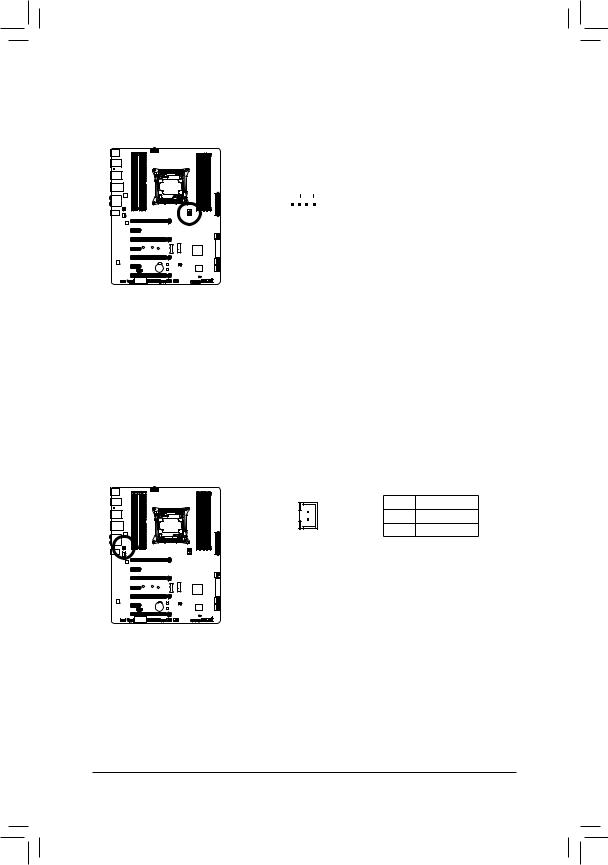
6)CPU_OPT (Water Cooling CPU Fan Header)
The fan header is 4-pin and possesses a foolproof insertion design. When connecting a fan cable, be sure to connect it in the correct orientation (the black connector wire is the ground wire). The speed control function requires the use of a fan with fan speed control design.
|
|
|
|
Pin No. |
Definition |
|
|
|
|
|
1 |
GND |
|
|
|
|
1 |
2 |
Speed Control |
|
|
|
|
|
3 |
Sense |
|
CPU_OPT |
||||||
4 |
VCC |
|||||
|
|
|
|
|||
7)LED_CON1 (I/O Shield Audio LED Power Connector)
The power connector provides power to the LEDs on the I/O shield on the motherboard back panel.
|
Pin No. |
Definition |
|
1 |
VCC |
1 |
2 |
GND |
|
|
Hardware Installation |
- 26 - |
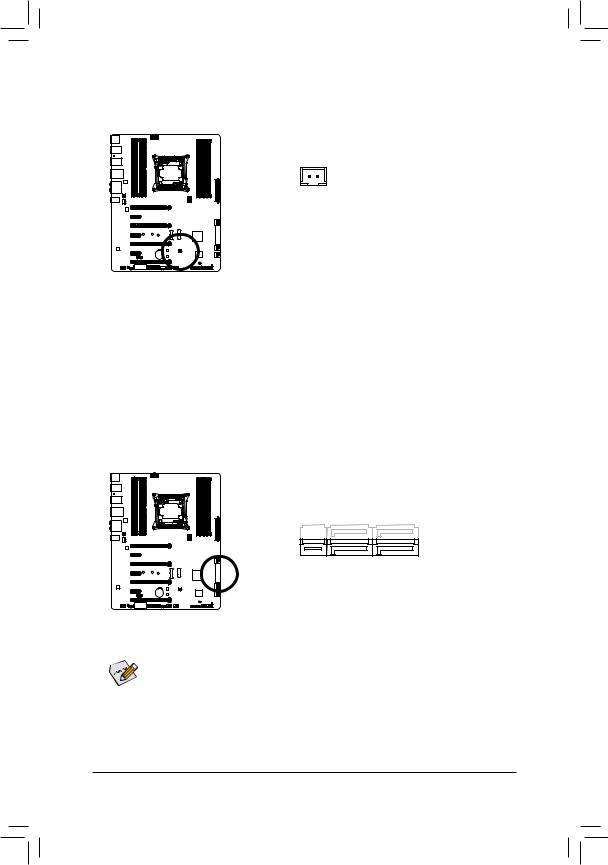
8)LED_CON2 (Heatsink LED Power Connector)
The power connector provides power to the LEDs on the Chipset heatsink.
|
Pin No. |
Definition |
1 |
1 |
VCC |
|
2 |
GND |
9)SATA_EXPRESS (SATA Express Connector)
The SATA Express connector supports a single SATA Express device.

 M2_10G, SATA Express, and SATA3 4/5 connectors can only be used one at a time. The SATA3 4/5 connectors
M2_10G, SATA Express, and SATA3 4/5 connectors can only be used one at a time. The SATA3 4/5 connectors  will become unavailable when an M.2 SSD is installed.
will become unavailable when an M.2 SSD is installed.
- 27 - |
Hardware Installation |

10)SATA3 0/1/2/3/4/5 (SATA 6Gb/s Connectors)
The SATA connectors conform to SATA 6Gb/s standard and are compatible with SATA 3Gb/s and SATA 1.5Gb/s
standard. Each SATA connector supports a single SATA device. The Intel® Chipset supports RAID 0, RAID 1,
RAID 5, and RAID 10. Refer to Chapter 3, "Configuring SATAHard Drive(s)," for instructions on configuring a RAID array.
|
SATA3 |
3 |
2 |
1 |
|
|
|
5 |
4 |
0 |
|
|
|
|
|
|
|
|||
7 |
|
|
|
1 |
||
7 |
|
|
|
1 |
||
|
|
|
|
|
|
|
|
Pin No. |
Definition |
||||
|
1 |
GND |
|
|
|
|
|
2 |
TXP |
|
|
|
|
|
3 |
TXN |
|
|
|
|
|
4 |
GND |
|
|
|
|
|
5 |
RXN |
|
|
|
|
|
6 |
RXP |
|
|
|
|
|
7 |
GND |
|
|
|
|
•• ARAID 0 or RAID 1 configuration requires at least two hard drives. If more than two hard drives are to be used, the total number of hard drives must be an even number.
•• ARAID 5 configuration requires at least three hard drives. (The total number of hard drives does not have to be an even number.)
•• A RAID 10 configuration requires four hard drives.
•• To enable hot-plugging for the SATA ports, refer to Chapter 2, "BIOS Setup," "Chipset\PCH SATA
Configuration," for more information.
11)sSATA3 0/1/2/3 (SATA 6Gb/s Connectors)
The SATA connectors conform to SATA 6Gb/s standard and are compatible with SATA 3Gb/s and SATA 1.5Gb/s standards. Only AHCI and IDE modes are supported. Each SATA connector supports a single SATA device.
sSATA3 |
3 |
1 |
|
|
2 |
0 |
|
||
|
|
|
||
7 |
|
|
1 |
|
7 |
|
|
1 |
|
|
|
|
|
|
|
Pin No. |
Definition |
||
|
1 |
|
GND |
|
|
2 |
|
TXP |
|
|
3 |
|
TXN |
|
|
4 |
|
GND |
|
|
5 |
|
RXN |
|
|
6 |
|
RXP |
|
|
7 |
|
GND |
|
To enable hot-plugging for the SATA ports, refer to Chapter 2, "BIOS Setup," "Chipset\PCH sSATA
Configuration," for more information.
Hardware Installation |
- 28 - |
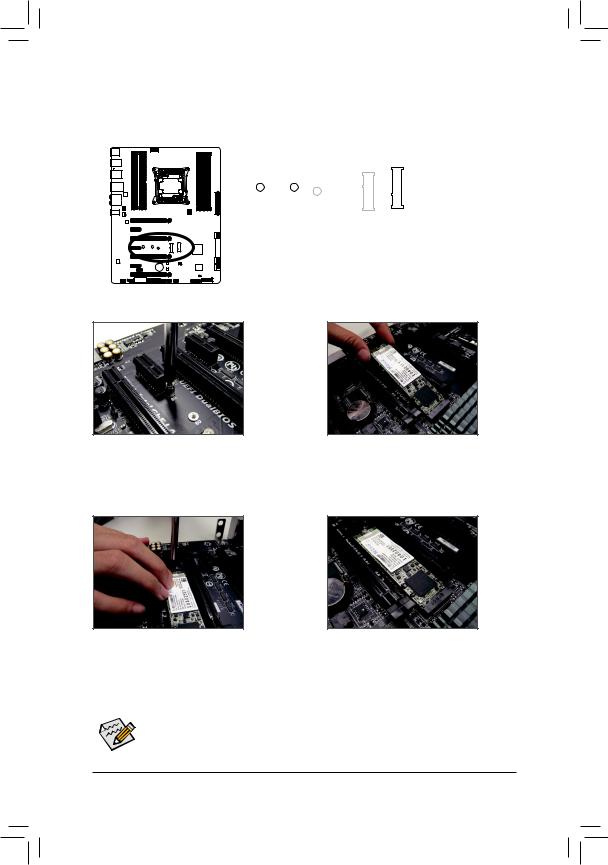
12)M2_10G (M.2 Socket 3 Connector)
You can insert an M.2 SSD into this connector.
Follow the steps below to correctly install an M.2 SSD in the M2_10G connector.
Step 1:
Use a screw driver to unfasten the screw and nut from the motherboard. Locate the proper mounting hole for the M.2 SSD to be installed and then screw the nut first.
Step 3:
Press the M.2 SSD down and then secure it with the screw.
Step 2:
Slide the M.2 SSD into the connector at an oblique angle.
Step 4:
The installation is completed, as shown in the picture above.
•• On the motherboard there are two length adjustment holes for the M.2 SSD. Select the proper hole for the M.2 SSD to be installed and refasten the screw and nut.
•• M2_10G, SATA Express, and SATA3 4/5 connectors can only be used one at a time. The SATA3 4/5 connectors will become unavailable when an M.2 SSD is installed.
- 29 - |
Hardware Installation |
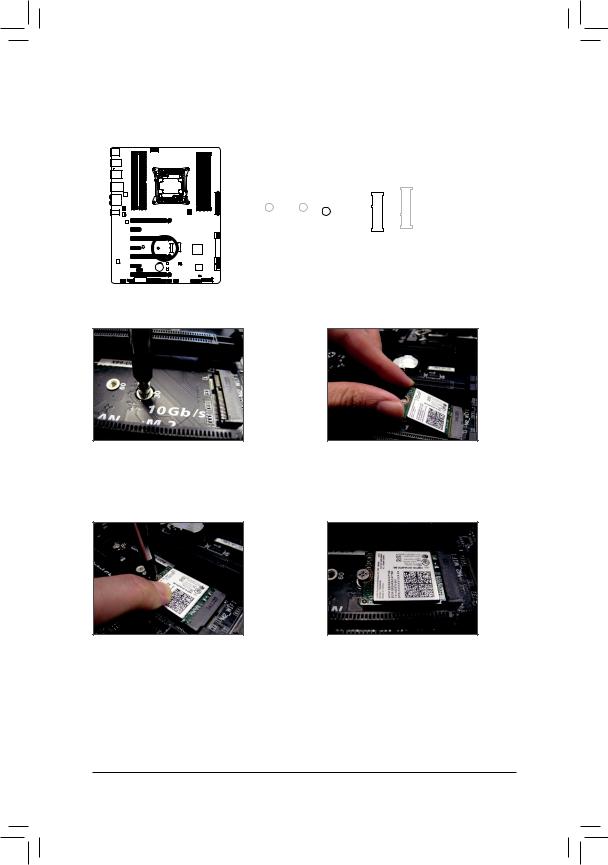
13)M2_WIFI (M.2 Socket 1 Connector)
You can insert an M.2 Wi-Fi module into this connector.
Follow the steps below to correctly install an M.2 Wi-Fi module in the M.2 Wi-Fi connector.
Step 1:
Use a screw driver to unfasten the screw from the motherboard.
Step 2:
Slide the M.2 Wi-Fi module into the connector at an oblique angle.
Step 3:
Press the M.2 Wi-Fi module down and then secure it with the screw.
Step 4:
The installation is completed, as shown in the picture above.
Hardware Installation |
- 30 - |
